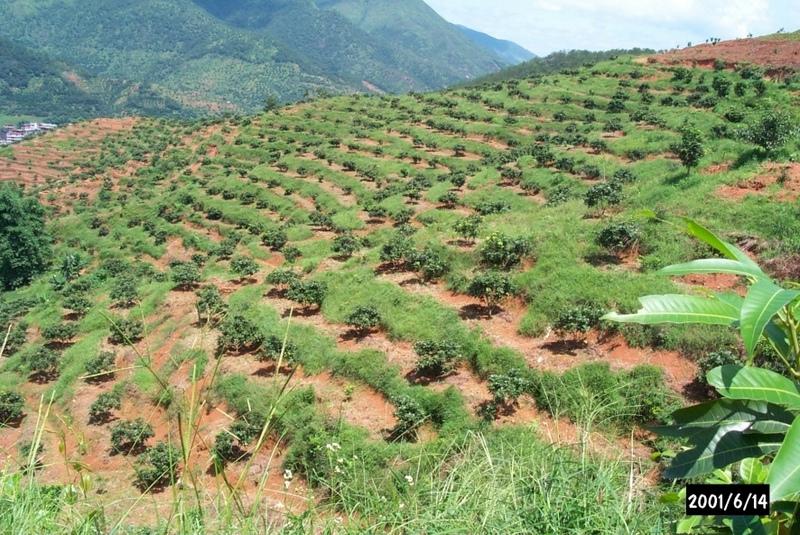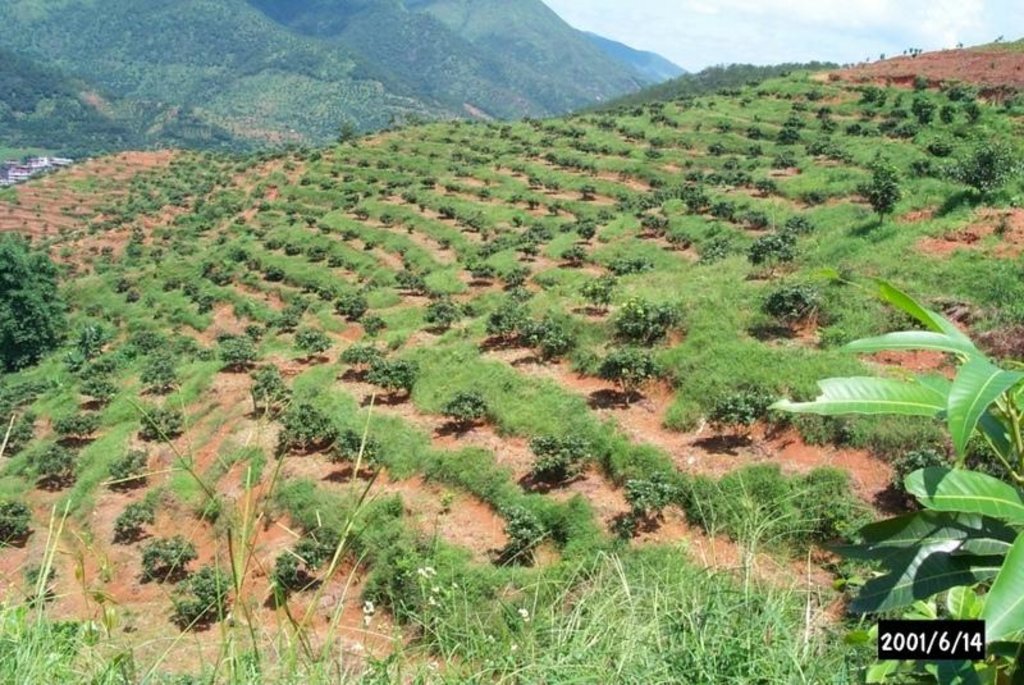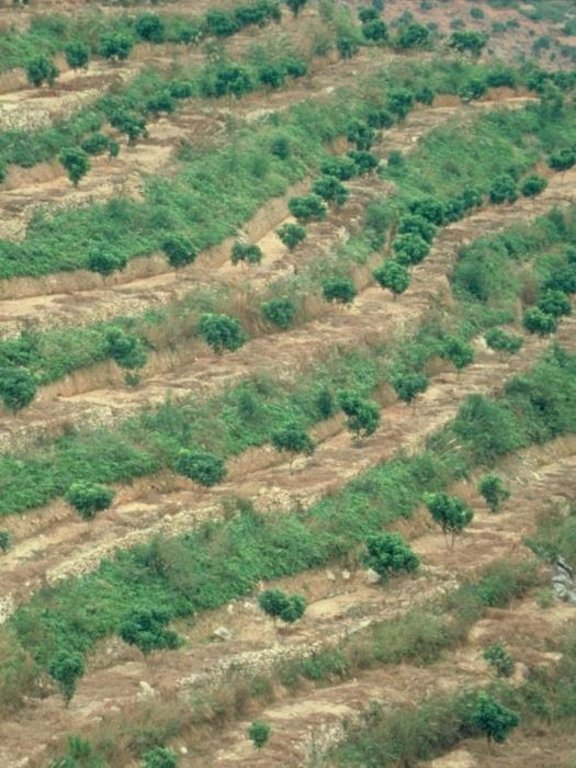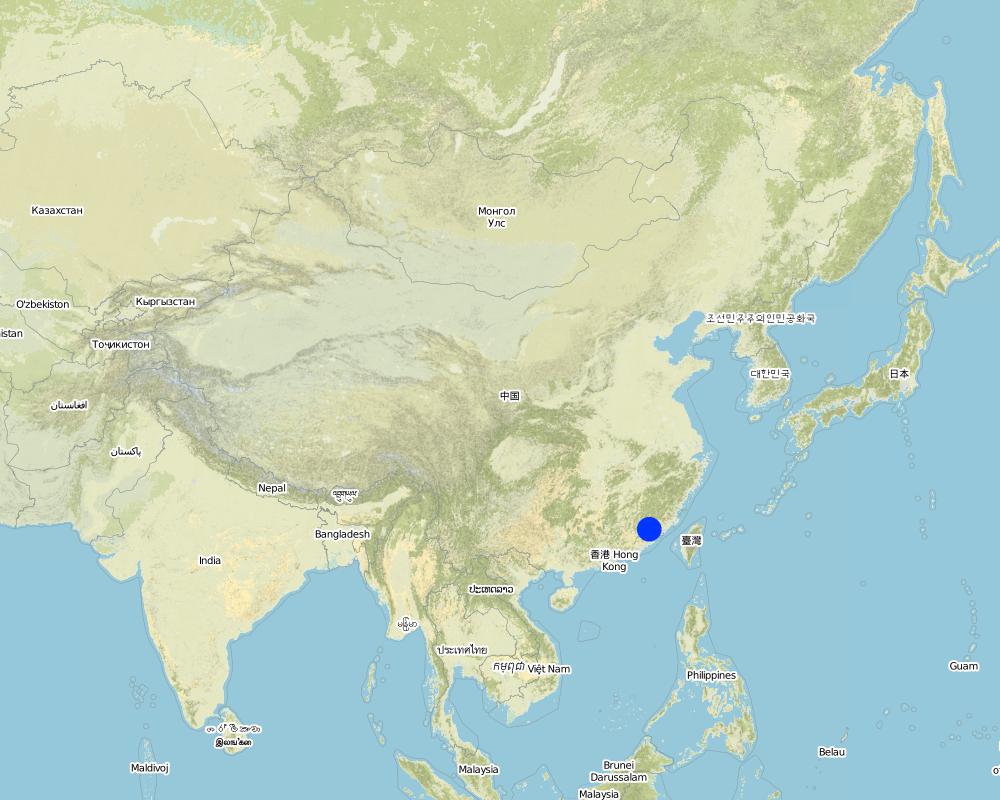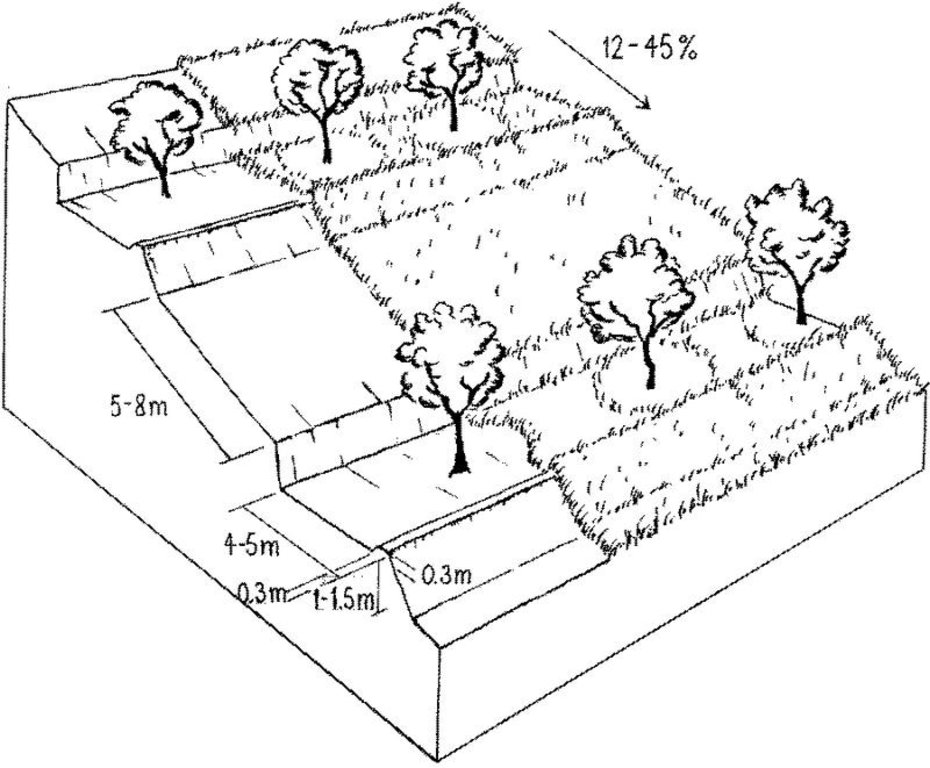Orchard terraces with bahia grass cover [الصين]
- تاريخ الإنشاء:
- تحديث:
- جامع المعلومات: Zhanguo Bai
- المحرر: –
- المراجعون: David Streiff, Deborah Niggli, Alexandra Gavilano
Bahia grass interplanted in orchard
technologies_1106 - الصين
عرض الأقسام
توسيع الكل طي الكل1. معلومات عامة
1.2 تفاصيل الاتصال بالأشخاص الرئيسيين لمصدر المعلومات والمؤسسات المشاركة في تقييم وتوثيق التقنية
الشخص (الأشخاص) الرئيسي لمصدر المعلومات
متخصص في الإدارة المستدامة للأراضي:
Liu Zhengming
Soil Conservation Office of Yongchun County
الصين
متخصص في الإدارة المستدامة للأراضي:
Nie Bijuan
Fujian Soil and Water Conservation Experimental Station
الصين
متخصص في الإدارة المستدامة للأراضي:
Yang Xuezhen
Fujian Soil and Water Conservation Experimental Station
الصين
متخصص في الإدارة المستدامة للأراضي:
اسم المشروع الذي سهّل توثيق/تقييم التقنية (إذا كان ذلك على صلة)
Book project: where the land is greener - Case Studies and Analysis of Soil and Water Conservation Initiatives Worldwide (where the land is greener)اسم المؤسسة (المؤسسات) التي سهلت توثيق/تقييم التقنية (إذا كان ذلك على صلة)
ISRIC World Soil Information (ISRIC World Soil Information) - هولندااسم المؤسسة (المؤسسات) التي سهلت توثيق/تقييم التقنية (إذا كان ذلك على صلة)
Soil Conservation Office of Yongchun (SCOY) - الصيناسم المؤسسة (المؤسسات) التي سهلت توثيق/تقييم التقنية (إذا كان ذلك على صلة)
Fujian Soil and Water Conservation Office (Fujian Soil and Water Conservation Office) - الصين1.3 الشروط المتعلقة باستخدام البيانات الموثقة من خلال WOCAT
يوافق جامع المعلومات والشخص (لاشخاص) الرئيسي لمصدر المعلومات على الشروط المتعلقة باستخدام البيانات الموثقة من خلال WOCAT:
نعم
2. وصف تقنيةالإدارة المستدامي للأراضي
2.1 وصف مختصر للتقنية
تعريف التقنية:
Rehabilitation of degraded hillsides through the establishment of fruit trees on slope-separated orchard terraces, with bahia grass planted as protective groundcover.
2.2 وصف تفصيلي للتقنية
الوصف:
In this case study orchards were established between 1991 and 1992 on degraded and unproductive hillsides (wasteland), with slopes of 12-45%. This was achieved by constructing level beds on the contour, mainly as continuous slope-separated orchard terraces, but in some cases as individual planting platforms. Terrace construction was generally undertaken by hand using hoes and shovels.
Purpose of the Technology: A typical terrace has a 4-5 m wide bed and a 1.0-1.5 m high riser. Commonly, a raised earth lip (0.3 m high) is constructed on the terrace edge to retain rainwater. The terrace riser walls are not protected. Even before terrace construction there was little topsoil and in some places the upper subsoil had been lost to erosion. The establishment of fruit trees (lychee, Litchi chinensis and longan, Dimocarpus longan) therefore required deep planting holes (1 m3), filled with organic matter/manure, into which seedlings were planted. In subsequent years additional large quantities of organic matter/manure were applied in circular trenches to the side of the trees, succeeding trenches being gradually further away as the trees grew. Bahia grass (Paspalum notatum) was planted for SWC purposes as a cover crop, to stabilise terrace risers and to improve soil fertility. It has not been used for fodder in this case. The germination rate of bahia grass seeds is comparatively low; therefore instead of direct seeding, nurseries were established to produce seedlings. The bahia grass seedlings were transplanted onto the terrace risers and beds (leaving a space around each fruit tree) and on the hillside slopes between the terraces. The grass grew and spread quickly, restoring a protective vegetative cover following terrace construction.
Natural / human environment: The primary overall purpose of the technology was to rehabilitate degraded hillsides through the planting of economically valuable fruit trees. Terracing reduces soil erosion while retaining most of the rainwater. The application of organic matter creates improved rooting conditions, while restoring and maintaining soil fertility. The bahia grass further provides protective groundcover preventing splash erosion, increasing surface roughness, and thereby slowing down runoff velocity, while contributing to the restoration of the soil’s biological, chemical and physical properties. Irrigation ditches dug along the terraces help to reduce erosion further. This project was planned by SWC specialists: around 6,000 families were allocated orchard plots and provided with seedlings at a subsidised price.
2.3 صور التقنية
2.5 البلد/المنطقة/المواقع التي تم تنفيذ التقنية فيها والتي يغطيها هذا التقييم
البلد:
الصين
المنطقة/الولاية/المحافظة:
Fujian Province
مزيد من التفاصيل حول الموقع:
Yongchun County
حدد انتشار التقنية:
- منتشرة بالتساوي على مساحة
إذا كانت التقنيةا موزعة بالتساوي على منطقة ما، حدد المساحة المغطاة (بالكيلومتر المربع):
55,0
إذا كانت المساحة الدقيقة غير معروفة، فيرجى الإشارة إلى المنطقة التقريبية المغطاة:
- 100-10 كم2
التعليقات:
Total area covered by the SLM Technology is 55 km2.
This is a part of the comprehensive development of Shan Huxi small watershed.
Map
×2.6 تاريخ التنفيذ
في حالة عدم معرفة السنة بالتحديد، يرجى الإشارة إلى التاريخ التقريبي:
- منذ أقل من 10 سنوات (مؤخرًا)
2.7 إدخال التقنية
حدد كيف تم إدخال التقنية:
- من خلال المشاريع/ التدخلات الخارجية
التعليقات (نوع المشروع، الخ):
The technology comes from the soil conservation theory books and accumulated experiences over years.
3. تصنيف تقنية الإدارة المستدامي للأراضي
3.1 الغرض الرئيسي ( الأغراض الرئيسية) للتقنية
- الحد من تدهور الأراضي ومنعه وعكسه
3.2 نوع (أنواع) استخدام الأراضي الحالية حيث يتم تطبيق التقنية
استخدامات الأراضي مختلطة ضمن نفس وحدة الأرض:
نعم
حدد استخدام الأراضي المختلطة (المحاصيل / الرعي / الأشجار):
- الحراجة الزراعية

الأراضي الزراعية
- زراعة سنوية
- زراعة الأشجار والشجيرات
الزراعة السنوية - حدد المحاصيل:
- محاصيل الأعلاف - الأعشاب
زراعة الأشجار والشجيرات -حدد المحاصيل:
- الفواكه ذات النواة (الخوخ، المشمش، الكرز، البرقوق، الخ)
حدد:
Longest growing period in days: 365Longest growing period from month to month: May - Sep

الغابات/ الأراضي الحرجية
منتجات وخدمات:
- الخشب
- الفواكه والمكسرات
- حفظ/حماية الطبيعة
التعليقات:
Crop: bahia grass
Tree and shrub cropping: lychee, Litchi chinensis and longan, Dimocarpus longan
Major land use problems (compiler’s opinion): Degraded and unproductive hillside slopes (wasteland), with low and declining soil fertility, subject to severe soil erosion
(sheet, rill, gully and mass movement) during periods of heavy and prolonged rainfall.
Major land use problems (land users’ perception): Low fruit yield and little income after consideration of input.
Problems / comments regarding forest use: The farmers\' consciousness of soil conservation are gradually improved and their ability of forest protection are also increased.
Forest products and services: timber, fruits and nuts, nature conservation / protection
Constraints of wasteland (before SWC)
Forest/ woodlands: Also nature conservation / protection
3.4 إمدادات المياه
إمدادات المياه للأرض التي يتم تنفيذ التقنية عليها:
- مختلط بعلي-مروي
3.5 مجموعةالإدارة المستدامة للأراضي التي تنتمي إليها هذه التقنية
- تحسين الغطاء الأرضي/النباتي
- hillside stabilizing and restoration
3.6 التدابير التقنية في مجال إلادارة المستدامة للأراضي

التدابير الزراعية
- A7: أخرى

التدابير النباتية
- V5: أخرى

التدابير البنيوية
- S1: المصاطب المتدرجة
التعليقات:
Main measures: agronomic measures, vegetative measures, structural measures
Secondary measures: management measures
3.7 الأنواع الرئيسية من تدهور الأراضي التي تناولتها التقنية

تآكل التربة بالمياه
- الوزن(Wt): فقدان التربة السطحية/تآكل السطح
- (Wg):الانجراف الخلجاني/ الخلجان
- (Wm): مجموعة كبيرة من الحركات الأرضية/انزلاقات أرضية

التدهور الكيميائي للتربة
- (Cn): تراجع الخصوبة وانخفاض محتوى المادة العضوية (غير ناتج عن الانجراف)
التعليقات:
Main type of degradation addressed: Wt: loss of topsoil / surface erosion, Wg: gully erosion / gullying, Wm: mass movements / landslides, Cn: fertility decline and reduced organic matter content
Main causes of degradation: deforestation / removal of natural vegetation (incl. forest fires), land tenure (land subdivision)
Secondary causes of degradation: over-exploitation of vegetation for domestic use, other human induced causes (specify) (agricultural causes), poverty / wealth (lack of captial), education, access to knowledge and support services (lack of knowledge)
3.8 منع أو حد أو عكس تدهور الأراضي
تحديد هدف التقنية فيما يتعلق بتدهور الأراضي:
- الحد من تدهور الأراضي
التعليقات:
Main goals: mitigation / reduction of land degradation
4. المواصفات الفنية، وأنشطة التنفيذ، والمدخلات، والتكاليف
4.1 الرسم الفني للتقنية
المواصفات الفنية (المتعلقة بالرسم الفني):
Fruit trees on slope-separated terraces with a spacing of 5-8 metres between (dependent on slope). Terrace risers and beds are protected by the fast spreading bahia grass (right): note a grass-free space is maintained around each tree.
Technical knowledge required for field staff / advisors: high
Technical knowledge required for land users: moderate
Main technical functions: control of raindrop splash, reduction of slope angle, improvement of ground cover, increase in organic matter, increase in soil fertility, control of dispersed runoff
Secondary technical functions: increase of surface roughness, increase / maintain water stored in soil, improvement of soil structure
Agronomic measure: organic matter application
Vegetative measure: aligned trees
Vegetative material: T : trees / shrubs
Vegetative measure: dispersed grass
Vegetative material: T : trees / shrubs
Width within rows / strips / blocks (m): 6
Vegetative measure: Vegetative material: T : trees / shrubs
Vegetative measure: Vegetative material: T : trees / shrubs
Fruit trees / shrubs species: longan, lychee
Grass species: bahia
Slope (which determines the spacing indicated above): 16.00%
If the original slope has changed as a result of the Technology, the slope today is (see figure below): 12.00%
Gradient along the rows / strips: 9.00%
Terrace: forward sloping
Height of bunds/banks/others (m): 1-1.5
Width of bunds/banks/others (m): 4-5
Construction material (earth): Using earth for the construction can reduce investment.
Slope (which determines the spacing indicated above): 25%
If the original slope has changed as a result of the Technology, the slope today is: 20%
Lateral gradient along the structure: 6%
For water harvesting: the ratio between the area where the harvested water is applied and the total area from which water is collected is: 1:20
Vegetation is used for stabilisation of structures.
Other type of management: Changing land use patterns - Mountain and hilly areas closure for recover of the forest and grass.
المؤلف:
Mats Gurtner
4.2 معلومات عامة بخصوص حساب المدخلات والتكاليف
حدد العملة المستخدمة لحساب التكاليف:
- دولار أمريكي USD
اذكر متوسط تكلفة أجر العمالة المستأجرة في اليوم الواحد:
3.00
4.3 أنشطة التأسيس
| النشاط | التوقيت (الموسم) | |
|---|---|---|
| 1. | 2.On each terrace one line of fruit trees was established. Deep planting | winter of 1991 |
| 2. | 2.Fruit tree seedlings were planted. Spacing between trees was | spring of 1992 |
| 3. | 3.Bahia grass was transplanted onto the terraced hillside | spring of 1992 |
| 4. | Terraces were constructed by hand.Soil was excavated from the upper portion of the terrace and used to build up the lower portion behind the terrace riser wall to create a level platform (bed). Part of the excavated soil was used to build a terrace lip. | winter of 1991 |
| 5. | land preparation for the grass planting | winter of 1991 |
| 6. | hill closure | Nov. 1999 |
4.4 التكاليف والمدخلات اللازمة للتأسيس
| تحديد المدخلات | الوحدة | الكمية | التكاليف لكل وحدة | إجمالي التكاليف لكل مدخل | % من التكاليف التي يتحملها مستخدمو الأراضي | |
|---|---|---|---|---|---|---|
| العمالة | Voluntary and paid | ha | 1,0 | 840,0 | 840,0 | 100,0 |
| المواد النباتية | Bahia transplants | ha | 1,0 | 435,0 | 435,0 | |
| المواد النباتية | Fruit tree seedlings | ha | 1,0 | 350,0 | 350,0 | 60,0 |
| الأسمدة والمبيدات الحيوية | fertilizer | ha | 1,0 | 145,0 | 145,0 | 100,0 |
| الأسمدة والمبيدات الحيوية | compost/manure | ha | 1,0 | 70,0 | 70,0 | 100,0 |
| إجمالي تكاليف إنشاء التقنية | 1840,0 | |||||
| إجمالي تكاليف إنشاء التقنية بالدولار الأمريكي | 1840,0 | |||||
إذا تحمل مستخدم الأرض أقل من 100% من التكاليف، حدد من قام بتغطية التكاليف المتبقية:
NA
التعليقات:
Duration of establishment phase: 24 month(s)
4.5 الصيانة/الأنشطة المتكررة
| النشاط | التوقيت/الوتيرة | |
|---|---|---|
| 1. | 2.Digging trenches by the side of the fruit trees and filling with organic | |
| 2. | prune, fertilize, pest control for the fruit trees of Longan and Litchi | spring, autumn and winter /3 times/year |
| 3. | grass plantation, fertilizaion | spring and summer /3 times/year |
| 4. | Filling any gaps in the bahia grass. | |
| 5. | In the first 1–2 years maintenance also involves replacing any fruit tree | |
| 6. | Weeding around the trees. | |
| 7. | Repairing terraces damaged by storms. | after raining season/4 times/year |
| 8. | regular inspection and management | Jan. 1991 / 6 times/year |
4.6 التكاليف والمدخلات اللازمة للصيانة/للأنشطة المتكررة (سنويًا)
| تحديد المدخلات | الوحدة | الكمية | التكاليف لكل وحدة | إجمالي التكاليف لكل مدخل | % من التكاليف التي يتحملها مستخدمو الأراضي | |
|---|---|---|---|---|---|---|
| العمالة | Voluntary and paid | ha | 1,0 | 144,0 | 144,0 | 100,0 |
| المواد النباتية | Bahia transplants | ha | 1,0 | 58,0 | 58,0 | 100,0 |
| المواد النباتية | Fruit tree seedlings | ha | 1,0 | 36,0 | 36,0 | 100,0 |
| الأسمدة والمبيدات الحيوية | fertilizer | ha | 1,0 | 84,0 | 84,0 | 100,0 |
| الأسمدة والمبيدات الحيوية | biocides | ha | 1,0 | 10,0 | 10,0 | 100,0 |
| الأسمدة والمبيدات الحيوية | compost/manure | ha | 1,0 | 44,0 | 44,0 | 100,0 |
| إجمالي تكاليف صيانة التقنية | 376,0 | |||||
| إجمالي تكاليف صيانة التقنية بالدولار الأمريكي | 376,0 | |||||
إذا تحمل مستخدم الأرض أقل من 100% من التكاليف، حدد من قام بتغطية التكاليف المتبقية:
NA
التعليقات:
Machinery/ tools: hoe, shovel
For establishment: 200 person days for terrace construction, 100 for digging pits and planting trees, 50 for transplanting
bahia grass. For maintenance: 15 person days for terrace maintenance, 40 for digging organic matter trenches, 5 for
bahia grass gap filling. The SWC department produces bahia transplants in nurseries; these are then distributed to the
farmers.
4.7 أهم العوامل المؤثرة على التكاليف
قدم وصفا لأهم العوامل التي تؤثر على التكاليف:
steep slope and lots of civil work.
5. البيئة الطبيعية والبشرية
5.1 المناخ
هطول الأمطار السنوي
- < 250 مم
- 251- 500 ملم
- 501 - 750ملم
- 1,000-751 ملم
- 1,500-1,100 ملم
- 2,000-1,500 ملم
- 3,000-2,001 ملم
- 4,000-3,100 ملم
- > 4000 ملم
المنطقة المناخية الزراعية
- رطبة
5.2 طوبوغرافيا
متوسط الانحدارات:
- مسطح (0-2%)
- بسيط (3-5%)
- معتدل (6-10%)
- متدحرج (11-15%)
- تلال (16-30%)
- شديدة الانحدار(31-60%)
- فائقة الانحدار (>60%)
التضاريس:
- هضاب/سهول
- أثلام مرتفعة
- المنحدرات الجبلية
- منحدرات التلال
- منحدرات في السفوح
- قاع الوادي
المنطقة الارتفاعية:
- 100-0 متر فوق سطح البحر
- 500-101 متر فوق سطح البحر
- 1,000-501 متر فوق سطح البحر
- 1,500-1,001 متر فوق سطح البحر
- 2,000-1,501 متر فوق سطح البحر
- 2,500-2,100 متر فوق سطح البحر
- 3,000-2,501 متر فوق سطح البحر
- 4,000-3,001 متر فوق سطح البحر
- > 4000 متر فوق سطح البحر
وضح ما إذا كانت التقنية مطبقة على وجه التحديد في:
- غير ذات صلة
5.3 التربة
متوسط عمق التربة:
- ضحل جدًا (0-20 سم)
- ضحلة (21-50 سم)
- متوسطة العمق (51-80 سم)
- عميقة (81-120 سم)
- عميقة جدًا (> 120 سم)
قوام التربة (التربة السطحية):
- خشن / خفيف (رملي)
المواد العضوية في التربة السطحية:
- متوسطة (1-3%)
- منخفضة (<1%)
5.6 خصائص مستخدمي الأراضي الذين يطبقون التقنية
التوجه السوقي لنظام الإنتاج:
- تجاري/سوق
الدخل من خارج المزرعة:
- 10-50% من جميع الإيرادات
المستوى النسبي للثروة:
- متوسط
- ثري
مستوى المكننة:
- عمل يدوي
- الجر الحيواني
اذكر الخصائص الأخرى ذات الصلة لمستخدمي الأراضي:
Population density: 200-500 persons/km2
Annual population growth: < 0.5%
5% of the land users are very rich and own 10% of the land.
40% of the land users are rich and own 35% of the land.
50% of the land users are average wealthy and own 45% of the land.
5% of the land users are poor and own 10% of the land.
Off-farm income specification: off-farm income is mainly from factory labour
5.7 متوسط مساحة الأرض التي يستخدمها مستخدمو الأراضي الذين يطبقون التقنية
- < 0.5 هكتارا
- 0.5 - 1 هكتار
- 1 -2 هكتار
- 2 - 5 هكتار
- 5 - 15 هكتار
- 15 - 50 هكتار
- 50 - 100هكتار
- 500-100 هكتار
- 1,000-500 هكتار
- 10,000-1,000 هكتار
- > 10,000 هكتار
5.8 ملكية الأراضي، وحقوق استخدام الأراضي، وحقوق استخدام المياه
ملكية الارض:
- دولة
حقوق استخدام الأراضي:
- مؤجر
6. الآثار والتصريحات الختامية
6.1 الآثار التي أظهرتها التقنية في الموقع
الآثار الاجتماعية والاقتصادية
الإنتاج
إنتاج المحاصيل
الدخل والتكاليف
دخل المزرعة
عبء العمل
آثار اجتماعية واقتصادية أخرى
input constraints
التعليقات/ حدد:
organic matter/manure
الآثار الاجتماعية والثقافية
المؤسسات المجتمعية
المؤسسات الوطنية
التخفيف من حدة الصراع
الآثار الايكولوجية
دورة المياه / الجريان السطحي
حصاد / جمع المياه
التعليقات/ حدد:
rainwater retention
الجريان السطحي
الكمية قبل الإدارة المستدامة للأراضي:
70
الكمية بعد الإدارة المستدامة للأراضي:
35
التربة
رطوبة التربة
غطاء التربة
فقدان التربة
الكمية قبل الإدارة المستدامة للأراضي:
24.3
الكمية بعد الإدارة المستدامة للأراضي:
3
المادة العضوية في التربة/تحت الطبقة c
الآثار الايكولوجية الأخرى
erosion due to raindrop splash
competition between fruit trees and bahia grass
6.2 الآثار التي أظهرتها التقنية خارج الموقع
تدفقات مائية موثوقة ومستقرة في موسم الجفاف
الفيضان في اتجاه مجرى النهر
تراكم الطمي باتجاه مصب النهر
6.4 تحليل التكلفة والعائد
كيف يمكن مقارنة العوائد نسبة لتكاليف الإنشاء (من وجهة نظر مستخدمي الأراضي)؟
عوائد قصيرة الأجل:
إيجابي قليلا
عوائد طويلة الأجل:
ايجابي جدا
كيف تتم مقارنة العوائدمع كلفة الصيانة/التكاليف المتكررة (من وجهة نظر مستخدمي الأراضي)؟
عوائد قصيرة الأجل:
إيجابي قليلا
عوائد طويلة الأجل:
ايجابي جدا
6.5 اعتماد التقنية
- > 50%
إذا كان متاحًا، قم بتحديد الكمية (عدد الأسر المعيشية و/أو المساحةالمغطاة):
6593 Households (56 percent of the area)
من بين جميع الذين تبنوا التقنية، كم عدد الذين فعلوا ذلك بشكل تلقائي، أي دون تلقي أي حوافز مادية/مدفوعات؟:
- 11-50%
التعليقات:
88% of land user families have adopted the Technology with external material support
5755 land user families have adopted the Technology with external material support
Comments on acceptance with external material support: estimates
12% of land user families have adopted the Technology without any external material support
784 land user families have adopted the Technology without any external material support
Comments on spontaneous adoption: estimates
There is a little trend towards spontaneous adoption of the Technology
Comments on adoption trend: There is a slow spontaneous adoption of the technology, based on the fact that bahia grass is remarkably helpful in controlling soil erosion.
6.7 نقاط القوة / المزايا / الفرص التي توفرها التقنية
| نقاط القوة/ المزايا/ الفرص من وجهة نظر جامع المعلومات أو غيره من الاشخاص الرئيسيين لمصدر المعلومات |
|---|
|
An increase in vegetative cover reduces erosion, improves the ecological environment, increases soil fertility and organic matter content, improves How can they be sustained / enhanced? Control weeds and fertilize well. |
|
The combination of structural and vegetative measures has a quick impact on reducing soil erosion and preventing mass movement on hillside slopes How can they be sustained / enhanced? ncrease the vegetative cover and improve soil properties through the addition of plenty of organic matter/manure. |
|
Improved land management practices bringing back degraded wasteland sites into economic production How can they be sustained / enhanced? Demonstration and extension while also improving the enabling legislative environment. |
| Editors’ comments: In China, large areas of degraded hillsides have been brought back into production by constructing terraces on which fruit trees are planted. In this example the technology has been further improved through planting of bahia grass, as a groundcover, to restore the structure and increase the soil organic matter. On a much smaller scale a case of degraded land conversion is presented from Tajikistan. |
6.8 نقاط ضعف / مساوىء / مخاطر التقنية وسبل التغلب عليها
| نقاط الضعف/ المساوىء/ المخاطر من وجهة نظر جامع المعلومات أو غيره من الاشخاص الرئيسيين لمصدر المعلومات | كيف يمكن التغلب عليها؟ |
|---|---|
| Orchard development can extend too far up the slope, onto steep mountain sides | Reserve the upper slopes for forest, and restrict orchards to the lower slopes. |
| Potential competition for water and nutrients between the bahia grass | Clean weed (bahia grass included) in the area immediately around the fruit tree. |
| Increase in farm income becomes very positive only after fruit trees start | Consider replacing bahia grass with a more palatable perennial fodder plant to improve farm income in the short term. |
| Low germination rate of bahia seeds | Expand experimental studies (seed treatments, cuttings, taking splits, etc). |
7. المراجع والروابط
7.1 طرق جمع/مصادر المعلومات
7.2 المراجع للمنشورات المتاحة
العنوان، المؤلف، السنة، النظام القياسي الدولي لترقيم الكتب ISBN:
Acceptance Materials of Shan Huxi Small Watershed.. 2001.
متاح من أين؟كم التكلفة؟:
Soil Conservation Office of Yongchun County
الروابط والوحدات المواضيعية
توسيع الكل طي الكلالروابط
لا يوجد روابط
الوحدات المواضيعية
لا يوجد وحدات مواضيعية


